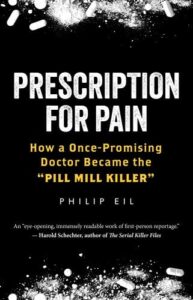Some books take longer than others.
In my case, I first heard about Dr. Paul Volkman – a med-school classmate of my dad who was charged with a massive prescription drug-dealing scheme that led to the deaths of numerous patients – in 2009, about a month before my 24th birthday. I knew instantly that there was a story to tell there, but…well, it took a while to tell it.
Fifteen years, to be exact.
My book about Volkman, Prescription for Pain: How a Once-Promising Doctor Became the “Pill Mill Killer,“ comes out today, just a few days before I turn 39.
A lot has happened in the years that I worked on this project. I spent 18 months as the news editor of my local alt-weekly paper before it closed in 2014. I taught writing and literature courses at a handful of different colleges. I took detours to write about mental health, Walt Whitman, and Joni Mitchell, among other subjects. And I sued the federal government under the Freedom of Information Act.
I also consumed a lot of true crime.
Some of what I watched, read, and listened to was highly-celebrated fare. These are the stories that many people have heard of – and for good reason. Season 1 of Serial. OJ: Made in America. The Paradise Lost trilogy. The Executioner’s Song. Columbine. Know My Name.
Other stories never became household names or inspired SNL skits. But they are worthy of celebration just the same. And, today, with the arrival of my long-awaited publication day, I wanted to give these storytellers some of the praise they deserve.
The following stories all made a tremendous impact on me. Each one expanded my idea of what true crime could do. Each one avoided the worst impulses of the genre: sensationalism, glibness, dehumanization. Each one takes the raw facts of awful events and turns them into something more.
“The Color of Blood” (published in the New Yorker), by Calvin Trillin
On an August night in 2006, a teenager was shot and killed on a cul-de-sac in Long Island. The victim, 17-year-old Daniel Cicciaro, was white. The man who shot him, 53-year-old John White, was black.
Trillin’s story about the incident is packed with explosive American subjects: race, class, guns, the justice system, the American Dream. And yet he navigates this material with a dancer’s grace and control.
The story is a marvel of concise, lyrical storytelling, and a reminder that Trilling – whose crime reportage is collected in the book Killings – is a master of the form.
Happy Valley directed by Amir-Bar Lev
Bar-Lev’s 2014 documentary isn’t a straightforward account of Penn State football coach Jerry Sandusky’s serial sexual abuse. It’s something far more interesting: a portrait of how the football-worshiping community around the crimes wrestled with them, and the complicity of revered-to-the-point-of-sainthood head football coach, Joe Paterno.
Over the course of the film, public murals featuring Sandusky and Paterno are re-painted. A statue of Paterno is removed. Students watch tearfully as the NCAA announces sanctions against the football program. At one point, a lawyer for Sandusky’s victims says that, for people in the region, convicting Sandusky was the easy part. “The tougher stuff is the self-examination,” he says.
The themes of this film – sports, power, institutions, and group psychology – resonate far beyond one Pennsylvania town.
“The Final, Terrible Voyage of the Nautilus” (published in WIRED), by May Jeong.
How do you write about the gruesome murder of a friend?
May Jeong offers an answer in this dazzling piece on Kim Wall, the 30-year old freelance journalist who was killed while interviewing a Danish inventor during a trip in his self-made submarine in 2017. (The inventor, Peter Madsen, was later convicted of her murder and sentenced to life in prison.)
Jeong’s article isn’t just a riveting crime narrative. It’s also an exploration of grief, a tribute to a friend, and a meditation on what it means to practice journalism as a woman.
At one point, Jeong describes how her editor made her promise that she wouldn’t put herself in harm’s way. “But much of reporting is just that—routinely putting yourself in uncomfortable positions,” she writes. “In the four months I spent on this story, I did things that in other circumstances might have seemed foolish. I went on long drives at night with sources. I met strangers on their doorsteps and entered their homes. In stepping onto that submarine, Kim was doing what any reporter onto a good story would have done.”
Tower, directed by Keith Maitland
Long before Sandy Hook, Virginia Tech, and Columbine, there was the University of Texas, where, on a sweltering August day in 1966, a gunman shot indiscriminately from the school’s clock tower, killing 15 and wounding 31 others.
Keith Maitland’s 2016 film depicts those events with various methods: archival video and audio footage, photographs, animation, contemporary documentary footage, and scripted scenes with actors that were then rotoscoped. It’s an experimental film that never feels hokey or disrespectful. And perhaps its boldest choice is an unwavering focus on the day’s victims and heroes – civilians and law enforcement, alike – instead of the crime’s perpetrator.
Every time I re-watch the film, I’m amazed by its emotional power.
I Will Find You: A Reporter Investigates the Life of the Man Who Raped Her, by Joanna Connors
In 2008, the Cleveland Plain Dealer published a five-part series by reporter Joanna Connors. “Almost every six minutes, a woman reports being raped in the United States,” read an Editor’s Note at the start of the series. “We’ll never know for certain how many women were raped in 1984, but one of them was Plain Dealer reporter Joanna Connors, who was then our theater critic. She was attacked on a deserted stage at Eldred Theater, on the campus of Case Western Reserve University.”
Connors’ 2016 book, which expands on that newspaper series, is a searing chronicle of her ordeal, told with a poet’s pen and a reporter’s precision.
Of her experiences at the hospital after the crime, she writes, “In the silent, chilled room, naked under the gown, I feel like a forgotten corpse, awaiting my own autopsy.” Later, when describing the criminal justice process, she observes, “‘My’ rape case isn’t mine at all – it’s the state’s…The prosecutor works for the people of Ohio. I am just a witness.”
The Blood of Emmett Till by Timothy B. Tyson
Tyson’s book is perhaps the best-known work on this list. It was a New York Times bestseller, a Washington Post notable book for 2017, and longlist-finalist for a National Book Award. But at a time when presidential candidates still proclaim, “We’ve never been a racist country,” no audience is too big for this account of one of the nation’s most notorious hate crimes.
A masterful work of research and storytelling, The Blood of Emmett Till is also a rebuke to historical revisionism. “The bloody and unjust arc of our history will not bend upward if we merely pretend that history did not happen here,” Tyson writes. “We cannot transcend our past without confronting it.”
***


















